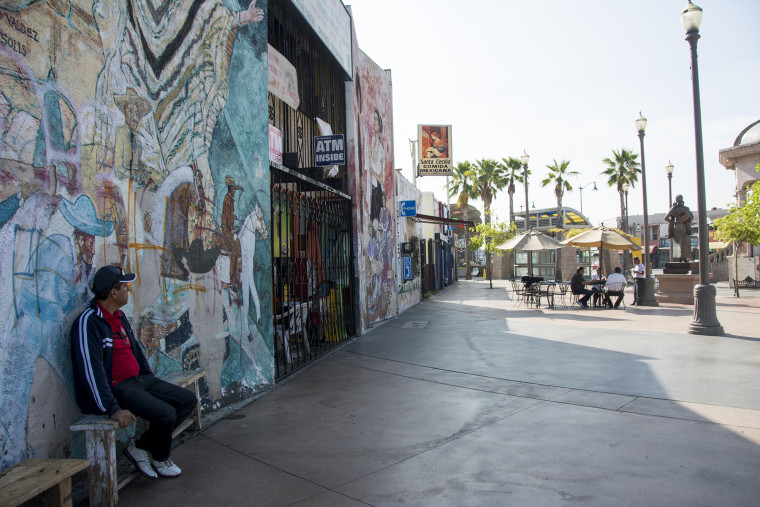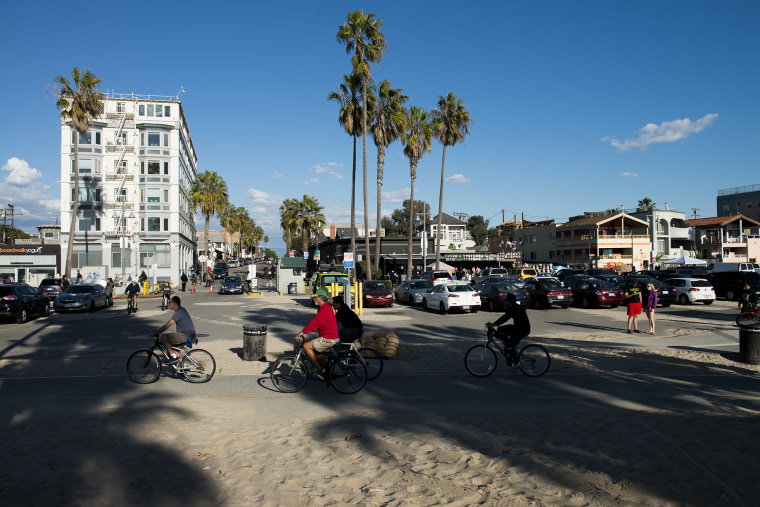Editor's Note: This report is part of a project on voting rights in America produced by the Carnegie-Knight News21 program.
MADERA, Calif. — Ed Gonzales has seen his city’s demographics shift since he started working as a teacher here in 1982.
Madera, a Central Valley town beaded with vineyards and almond groves, now has nearly 50 percent more Latino residents than it did 25 years ago, according to U.S. Census data. Incomes have dropped by about a third. Fewer people speak English.
For Gonzales, who oversees the town’s school district as superintendent, the area has undergone another significant shift. The local election system, driven by a change in state law, now seats members of the school board by district rather than at-large.
The result? Latinos now fill four of the board’s seven seats, compared with just one or two prior to the district system.
For decades, many Californians elected their representatives in at-large systems – like cities and towns across the United States. But an at-large voting system can lead to racially polarized voting – when politically powerful racial groups vote as a bloc, they can drown out the minority vote even if the minorities make up a considerable share of the population.
In 2002, the California Voting Rights Act became the first, and as yet only, state law in the country to strengthen a provision of the federal Voting Rights Act of 1965 that prohibits racial discrimination. California’s law has enabled plaintiffs to sue jurisdictions to switch to districts, which advocates say helps ensure minorities have a better chance at electing people who understand their neighborhoods. From Redding in the Cascade Mountains to Monterey along the central coast to the San Bernardino desert, more than 200 jurisdictions have switched to district systems since 2004.
Some communities have fought the changes, saying the system isn’t necessary, promotes division or encourages reverse discrimination.
Gonzales said some people don’t like the district setup adopted in Madera in 2008, and some think the quality of the board has suffered. He doesn’t agree.
RELATED: For Latinos, 1965 Voting Rights Act Impact Came A Decade Later
“You have a little bit more of a connection to somebody that actually lives in your neighborhood rather than the way it used to be, when five or seven people could live on the same two-block stretch of an upper-middle class part of town, and they’re the ones that called the shots,” he said.
Combined with the schools’ efforts at outreach and transparency, Gonzalez said families feel much more a part of the process, and board members feel more responsive to their constituents.
“And they should be.”

Voting rights attorney fought for decades to pass law
The law was Joaquin Avila’s brainchild.
In 1985, the longtime voting rights attorney and East Los Angeles native started authoring predecessors to the California Voting Rights Act, advancing bills that would ultimately face vetoes by the Republican governors of the 1980s and ‘90s.
By the early 2000s, with the installment of Democratic Gov. Gray Davis, Avila tried again. In 2002, the law went into effect.
Avila didn’t stop the fight, representing early plaintiffs who wanted to change their systems into districts. Avila said he learned right and wrong from his late father, a Mexican immigrant and foundry laborer.
RELATED: Tougher Voting Laws Will Heavily Impact Latinos in 2016: Report
The elder Avila came to the United States around 1946, but kept a green card for more than 40 years because he wanted to one day return to his native country. Avila’s father changed his mind in the 1990s during Gov. Pete Wilson’s reelection campaign.
Wilson took a hard line against illegal immigration with his staunch support of Proposition 187, a state law that would have denied public services to undocumented immigrants. Avila’s father was a legal resident, but would ask his son, “Why is he picking on us?” The campaign galvanized him.
“He became a U.S. citizen,” Avila said, “and voted.”

When the Mexican American Legal Defense and Education Fund hired Avila in 1974, one of his first assignments as a rookie lawyerwas a voting rights case. In 1985, he went solo as a voting rights specialist.
Avila, with colleague Robert Rubin, filed the first suit to enforce the law against the city of Modesto in 2004. The Central Valley city, in Stanislaus County about an hour south of Sacramento, fought the case in county court and initially succeeded on the argument that the new law favored minorities – as “reverse racial discrimination” and “unconstitutional affirmative action benefiting only certain racial groups,” according to a state appeals court decision reversing the county’s verdict. The California Supreme Court declined the city’s appeal.
The case took about four years to settle, with Modesto on the hook for $3 million.
Avila had a message for defendants: These are expensive cases to lose, and it’s cheaper to settle early.
Does race matter when it comes to representation?
Denise Hulett, national senior counsel for the Mexican American Legal Defense and Education Fund, said minority candidates have a hard time winning votes from white voters, and no law can address that. But, she said, governments can do something about an at-large system that enables the polarization.
The California law says plaintiffs only need to show that racially polarized voting exists in at-large systems to force the change to districts. This is a lower threshold than the federal law requires.

Since 2004, attorneys have filed about 30 lawsuits and issued dozens of threats to try to institute districts, according to data collected by districting experts. About 210 jurisdictions, from community college boards to city councils, have either voluntarily converted to district elections, lost or settled in court, or sent the question to a referendum. More than three-quarters of these have been school boards.
Morgan Kousser, a history and social science professor at the California Institute of Technology, studies the California Voting Rights Act. He said cash-strapped school districts began switching en masse, intimidated by Modesto’s multimillion-dollar liability.
Having a Latino on a school board is a breakthrough, Kousser said.
“You can imagine that for a bunch of Hispanic parents in that situation, it really makes a hell of a big difference if you’ve suddenly got somebody where you feel like this is not just a faceless Anglo bureaucracy. These are people that you can relate to.”
In Madera, a heavily agricultural town near Fresno where streets have names like Pecan and Merlot, about 90 percent of the more than 20,000 public schoolchildren are Latino, and about as many qualify for free or reduced lunch. More than a third are English-language learners.
School board President Al Galvez, who has lived in Madera for 35 years and served on its school board for almost two years, said that when the board was elected at-large, members paid more attention to the schools in affluent neighborhoods. It wasn’t that they didn’t care about the needs of other families, he said, they just didn’t have firsthand experience with the problems.
Galvez grew up in a poor migrant laborer family, spending his youth picking grapes, plums and cotton along the San Joaquin Valley. He worked the fields into college.
He eventually moved into the middle class. But he remembers the needs of families like his.
“I know that side of the street. I’ve been there. I know that,” he said. “My passion is to try to help.”
Almond trees give way to palm trees heading south into Fullerton. Kitty Jaramillo has lived in this Orange County city for all of her 62 years, raised in the barrio on the east side, and calls an ethnically mixed, middle-class neighborhood on the southwest side home.

Jaramillo, along with a Korean-American resident, sued the city last year. One of the complaints describes a compartmentalized city, with Latinos concentrated to the south, Asian-Americans to the northwest, and whites to the north, particularly the northeast. Jaramillo said council members almost always come from the well-heeled north side.
She described a popular Latina city councilwoman in the 2000s who, although also a resident of north Fullerton, engaged with southside Latinos, even drawing immigrants who couldn’t vote out to council and community events. Otherwise, Jaramillo said, residents on the south side haven’t felt close to a council member or felt they had a champion in city hall.
In a settlement, the city agreed to put the question of districts on the November ballot.
She said Latinos need other Latinos to represent them in Fullerton.
“There’s a certain familiarity or comfort level: ‘Wow, there’s somebody on city council that really cares about us,’” she said.

About two-and-a-half hours to the north, in the coastal city of Santa Barbara, Frank Bañales, 70, remembers when the city switched to an at-large system in the 1960s. He said the change made it hard for minorities to become involved in city politics.
He joined a lawsuit against Santa Barbara in 2014. The city settled and carved out six districts. The next year, voters elected a pair of Latinos.
Today, Latinos make up about40 percent of the population, concentrated in two of the new districts – the ones that produced the Latino representatives. Bañales said “as long as they do the work for the neighborhood,” it doesn’t matter if representatives are from the same race or ethnicity.
“That’s what district elections is about. It’s about getting your streetlights,” he said. “It’s about getting your streets fixed. It’s about taking care of crime in your neighborhood.”
Other communities that have switched to a district system have experienced changes in power as well. Compton, which African-Americans dominated for years but has a growing Latino population, elected its first Latino to the City Council in 2013. The school district in Cerritos, in the Long Beach area, now has a multi-ethnic school board of Latinos, Asian-Americans and whites.

John Dobard, manager of political voice for the Advancement Project’s California office, said there might be a direct relationship between the racial compositions of the boards and electorates after a law-induced conversion, but not necessarily.
Dobard said it can take time to see long-term change.
“It’s one way in which we can try to get fair representation and also try to encourage more participation,” he said. “(But)it’s unreasonable to expect a conversion to happen and then immediately to see mind-blowing results because you’re dealing with historical factors that have created particular conditions.”
Some communities push back
Roger Clegg, CEO of the Center for Equal Opportunity, a Virginia-based conservative think tank devoted to issues of race and ethnicity, said any racially based treatment is problematic.
“It’s still requiring the government to zig rather than zag when it’s drawing district lines,” Clegg said. “And basically, it is requiring racial gerrymandering and to some extent the racial segregation of voting districts.”
Santa Monica, outside of Los Angeles, is an affluent, mostly white seaside city. And it’s also defending itself against a lawsuit to force it to adopt district elections for city council.

It declared the lawsuit frivolous, citing two previous local elections that rejected districts by wide margins. It also said that Latinos are a minority even in some of the more ethnically diverse neighborhoods.
And other elected bodies within city limits – school, rent control and community college boards – all have at least one minority. In addition: Santa Monica’s current mayor, Tony Vazquez, and a councilwoman, Gleam Davis, are Latino.
A Los Angeles County Superior Court judge is scheduled to set a trial date in August.
Potential for spread in the West
Avila, who now lives in Seattle, still assists other attorneys with voting rights cases. He said he hopes to bring similar laws to Colorado, Texas and Arizona.
Hulett, from the Mexican American Legal Defense and Educational Fund, said she hasn’t studied all 50 states enough to know whether a California-style law would work nationwide. Some states might have such small and dispersed minority populations that districts might not make a difference, she added.
However, Hulett said her organization has been working on similar legislation in Illinois. She also pointed to efforts in Washington state, where district advocates scored a major victory in the city of Yakima.
Voters, led by the state chapter of the American Civil Liberties Union, won a lawsuit against the city in 2014 under the federal Voting Rights Act. The next year, three Latinas won seats on the Yakima City Council under newly drawn district lines.
RELATED: Scholars: Latinos Face Tactics to Dilute, Discourage Their Vote
The civil rights group points to the California law to show that it’s possible for states to have their own legal remedy, said Doug Honig, a spokesman for Washington’s ACLU.
But California also is a bit of an outlier compared with the rest of the country – 62 percent of its population is nonwhite, and registered Democrats far outnumber Republicans and independents. Outside of California, some jurisdictions have moved the opposite way. In Pasadena, Texas, outside Houston, the City Council converted two largely Latino districts to at-large seats in 2013. (Latino voters have sued to reverse the change.)
Nonetheless, California chips away at at-large voting.Just the number of jurisdictions that have transitioned to district elections shows that the law has been “a tremendous success,” Avila said.
“Political power is never given away, and you have very substantial economic interests at the local level that want to have a vested interest in making sure that the political status quo does not change,” Avila said. “For that reason, you have to have federal intervention and that’s why you have state intervention to level the playing field.”
This report is part of the project titled “Voting Wars – Rights | Power | Privilege,” produced by the Carnegie-Knight News21 initiative, a national investigative reporting project by top college journalism students across the country and headquartered at the Walter Cronkite School of Journalism and Mass Communication at Arizona State University.
